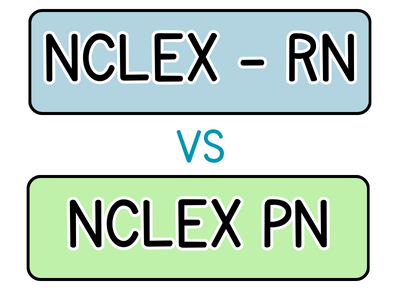NCLEX RN Vs. PN: Which Exam Is Harder?
NCLEX RN vs. PN, which exam aligns most with your nursing goals? NCLEX RN and PN are tests given by the NCSBN to assess if candidates are ready to work as nurses. The RN test is for becoming a Registered Nurse, and the PN test is for becoming a Practical Nurse.
The exams have different requirements, responsibilities, and job opportunities. Let me explain these differences!
NCLEX RN Vs. PN Comparison
Both exams assess the competency of nursing candidates, ensuring they meet the necessary standards for licensure. However, they have distinct educational requirements, scopes of practice, and career opportunities.
First, let’s look at this brief comparison table!
| Aspect | NCLEX-RN | NCLEX-PN |
|---|---|---|
| Educational Requirement | ADN or BSN | Board-approved practical program certificate |
| Distribution of Content | Deeper focus on Care Management and Pharmacological Therapies | More emphasis on Coordinated Care and Basic Comfort & Care |
| Pass Rates | 89.01% in 2023 | 86.67 % in 2023 |
| Test Fee | $200 | |
Now, let me analyze each difference between these two exams!
1. Educational Requirements
First, I’ll talk about recognizing different levels of nursing practice.
For the NCLEX-RN, candidates must possess a higher level of education, typically an ADN (Associate Degree) or a BSN (Bachelor of Science), on top of a high school diploma. ADN programs span 18 to 24 months, while the BSN takes 3 to 4 years.
Source: NurseJournal.org
On the other hand, the NCLEX-PN requires a high school diploma, with graduation from a board-approved program related to nursing. These programs generally last one year, focusing on foundational nursing skills and patient care.
As you can see, the NCLEX-PN requires a deeper understanding of nursing theory, critical thinking skills, and a broader scope of practice.

2. Structure & Distributions
RNs need to understand management and parenteral therapies more deeply, while PNs focus more on coordinated care and basic pharmacology.
| Categories | Subcategories | |
| NCLEX-RN | NCLEX-PN | |
| Effective & Safe Care Environment | – Care Management (17-23%) – Infection & Safety Control (9-15%) | – Coordinated Care (18-24%) – Infection & Safety Control (10-16%) |
| Health Maintenance & Promotion | N/A (6-12%) | N/A (6-12%) |
| Psychosocial Integrity | N/A (6-12%) | N/A (9-15%) |
| Physiological Integrity | – Basic Comfort & Care (6-12%) – Pharmacological & Parental Therapies (12-18%) – Risk Potential Reduction (9-15%) – Physiological Adaptation (11-17%) | – Basic Comfort & Care (7-13%) – Pharmacological Therapies (10-16%) – Risk Potential Reduction (9-15%) – Physiological Adaptation (7-13%) |
At first glance, the structure of The NCLEX-RN and PN exams is quite similar, with four main areas:
- Effective & Safe Care Environment
- Health Maintenance & Promotion
- Psychosocial Integrity
- Physiological Integrity
However, there are some variations. Specifically:
- In the Care Environment section, the RN focuses on Care Management, while the PN emphasizes Coordinated Care.
- In the Physiological Integrity part, the NCLEX-RN talks about Pharmacological & Parental Therapies, while the NCLEX-PN only mentions Pharmacological Therapies.
Let’s analyze more clearly!
In The Effective & Safe Care Environment Part
In this part, both exams test how well nurses can provide effective and safe care. But they focus on different tasks.
- NCLEX-RN
For NCLEX-RN, one part is about managing care. Nurses must know how to delegate tasks, keep patient information private, and ensure care continues smoothly.
Another is about infection and safety control. Nurses must prevent accidents, handle dangerous materials safely, and check patients for infections.
- NCLEX-PN
For NCLEX-PN, one part is about coordinating care. Nurses need to work well with others to ensure patients get good care; this includes understanding patient rights, how to manage care, and how to use technology.
The other part is also about safety and infection control, like in the NCLEX-RN.

In The Health Maintenance & Promotion Part
This section of both exams evaluates nurses’ abilities to support and maintain patient health through various means.
The RN exam delves deeper into assessment and management, while the PN exam focuses more on practical application and guidance.
For the NCLEX-RN, nurses are tested on their capacity to provide comprehensive client care considering stages of growth and development, including:
- Pre-pregnancy & Pregnancy
- Postpartum
- Newborn care
- Developmental stages
- Health screening
- Disease prevention
- Promoting healthy behaviors
On the other hand, the NCLEX-PN focuses on the practical aspects of health maintenance and promotion. PNs are expected to:
- Show understanding of developmental periods
- Provide care during pregnancy, childbirth, and postpartum
- Detect early health issues for preventative treatment
- Be proficient in data collection skills, disease prevention, health promotion, and offering guidance on lifestyle choices to clients
In The Psychosocial Integrity Part
In this part, both exams look at how nurses handle their patients’ mental, emotional, and social health.
However, RNs focus more on assessment and in-depth interventions, while PNs may concentrate on recognizing signs and providing support within their scope of practice.
Let me break this down!
For NCLEX-RN, nurses must show how they support patients with mental health issues or facing tough times. They must spot and prevent abuse/neglect, use behavior techniques, handle crises, and understand how culture affects health.
While the NCLEX-PN also focuses on supporting patients emotionally, mentally, and socially, PNs must recognize abuse/neglect risks, manage behaviors, identify signs of drug dependency, offer coping methods, and help in crises.

In The Physiological Integrity Part
The Physiological Integrity section of both exams is about how nurses help patients stay physically healthy. They both cover similar areas, like:
- Basic Comfort & are
- Pharmacological Therapies
- Risk Potential Reduction
- Physiological Adaptation.
Yet, there are differences based on the roles of RNs and PNs.
For NCLEX-RN, nurses learn how to care for patients in detail. They help with daily tasks, give comfort, and give medications. They also learn to watch for problems, like changes in treatments’ vital signs or complications.
In NCLEX-PN, nurses learn similar things, but it’s more about hands-on care. They focus on preventing complications and responding to emergencies.
3. Pass Rates
The pass rates for the NCLEX-RN and PN exams in 2023 show that slightly more first-time test takers passed the NCLEX-RN than the NCLEX-PN
According to the NCSBN, the RN pass rate was 89.01%, while the PN pass rate-was 86.67%.
Both exams utilize CAT technology, which tailors each test to each candidate; this means that the difficulty of the questions adapts based on the test taker’s previous answers.
As a result, an exam is unique to assess the candidate’s knowledge and competence level in nursing at an entry-level position.
4. Test Fee
Both the NCLEX-RN and PN exams have the same test fee, which is $200. You can pay the test fee directly to the testing organization, such as Pearson VUE (on behalf of the NCSBN).
The test fee covers various expenses associated with the administration of the exam, including:
- The development of test questions
- The use of CAT technology
- Test administration
- Scoring
- The issuance of leisure results
Note that besides the test fee, you also incur other costs related to preparing for the exam, such as:
- Study materials
- Review courses
- Registration fees for state boards of nursing

5. Salary And Job Opportunities
RNs and PNs often collaborate closely in various healthcare settings. Yet, there are differences in their job opportunities and salaries.
RNs primarily work in general surgical & medical hospitals, where more than 1.72 million RNs are employed (data from May 2022). LPNs also work in hospitals, but their numbers are lower, with around 80,100 LPNs reported in hospital employment.
Besides hospitals, both RNs and LPNs can work in physicians’ offices. Approximately 208,760 RNs and 79,130 PNs work in these settings. Yet, most LPNs work in nursing and residential care facilities. Whereas RNs are more prevalent in home health and educational services.
When it comes to salary, RNs generally earn higher salaries compared to LPNs. The median annual wage for RNs is around $81,220, while LPNs typically earn a median salary of about $54,620/year.
Sources: U.S. BUREAU OF LABOR STATISTICS
How To Prepare For NCLEX Tests?
Preparing for both exams requires careful planning and diligent study. Here are some effective strategies to help you based on my experience:
- Familiarize yourself with the exam’s format. Understand the types of questions you will meet, such as multiple-choice, SATA, and prioritization questions.
- Develop a study schedule to cover all the content areas. Allocate specific times for studying each topic, and include regular breaks to avoid burnout.
- Invest in reliable study materials such as review books, online resources, and practice questions.
- Practice answering NCLEX-style questions to build your test-taking skills and confidence.
As your exam date approaches, simulate test conditions by taking full-length practice exams. Practice managing your time and maintaining focus throughout the exam.
Can PN Students Later Become RNs?
Yes. PN students can advance their careers and become RNs through further education and training.
Many PN programs offer pathways for students to bridge to an RN program by completing extra coursework and clinical needs.
Also, PN students can pursue an ADN or BSN to become RNs. Once they have obtained their RN license, they can work in a wider range of healthcare settings and may have increased job opportunities and earning potential.
Wrap Up
The difference between the NCLEX RN vs PN tests comes down to the roles they prepare nurses for.
The NCLEX-RN covers a wider range of nursing skills and knowledge. Meanwhile, the NCLEX-PN is for practical or vocational nurses, focusing on basic nursing skills for providing direct care under supervision.
Let’s consider these distinctions and decide which exam suits you best!







